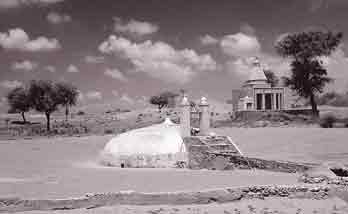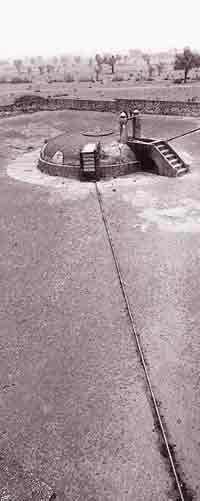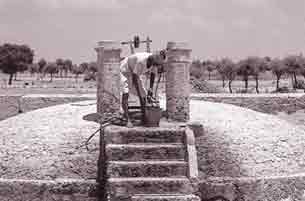 In the
sandier tracts, the villagers of the Thar Desert had evolved an ingenious system of
rainwater harvesting known as kunds or kundis. Kund,
the local name given to a covered underground tank, was developed primarily for
tackling drinking water problems. Usually constructed with local materials or cement, kunds
were more prevalent in the western arid regions of Rajasthan, and in areas where the
limited groundwater available is moderate to highly saline. Groundwater in Barmer, for
instance, in nearly 76 per cent of the district’s area, has total dissolved
salts (TDS) ranging from 1,500-10,000 parts per million (ppm). Under such conditions, kunds
provided convenient, clean and sweetwater for drinking. In the
sandier tracts, the villagers of the Thar Desert had evolved an ingenious system of
rainwater harvesting known as kunds or kundis. Kund,
the local name given to a covered underground tank, was developed primarily for
tackling drinking water problems. Usually constructed with local materials or cement, kunds
were more prevalent in the western arid regions of Rajasthan, and in areas where the
limited groundwater available is moderate to highly saline. Groundwater in Barmer, for
instance, in nearly 76 per cent of the district’s area, has total dissolved
salts (TDS) ranging from 1,500-10,000 parts per million (ppm). Under such conditions, kunds
provided convenient, clean and sweetwater for drinking. Kunds were owned by
communities or privately, with the rich having one or more kunds of their
own. Community kunds were built through village cooperation or by a rich man
for the entire community. The first known construction of a kund in western
Rajasthan was during 1607 AD by one Raja Sursingh in village Vadi-ka-Melan. In the
Mehrangarh Fort in Jodhpur, a kund was constructed during the regime of
Maharaja Udai Singh in 1759 AD. During the Great Famine of 1895-96, construction of kunds
was taken up on a wide scale. It is quite possible that kunds could have
been built even prior to 1607 AD in the villages of western Rajasthan. Jalwali, a village
on the road from Bikaner to Anupgarh has nearly 300 kunds. Since the area is
sandy, kunds have been constructed wherever the land slopes. Each household
owns four to five kunds.
 Before the
onset of rains every year, meticulous care was taken to clean up the catchment of the kunds.
Cattle grazing and entry with shoes into the catchment area of the kunds was
strictly prohibited. The proximity of a kund to the house or village
saved time and effort in searching for drinking water. Without a kund, households
in many parts of the Thar would have to make a 10-15 km round trip with a donkey, camel or
bullock cart to meet their water needs. Coupled with the benefits of cleanliness and
quality of water, the kund became an ideal device to collect drinking water.
Water-borne diseases, which are otherwise quite common in the desert area, are thus
reduced. Before the
onset of rains every year, meticulous care was taken to clean up the catchment of the kunds.
Cattle grazing and entry with shoes into the catchment area of the kunds was
strictly prohibited. The proximity of a kund to the house or village
saved time and effort in searching for drinking water. Without a kund, households
in many parts of the Thar would have to make a 10-15 km round trip with a donkey, camel or
bullock cart to meet their water needs. Coupled with the benefits of cleanliness and
quality of water, the kund became an ideal device to collect drinking water.
Water-borne diseases, which are otherwise quite common in the desert area, are thus
reduced.
The kund consists of a saucer-shaped catchment area with a gentle slope
towards the centre where a tank is situated. Openings or inlets for water to go into the
tank are usually guarded by a wire mesh to prevent the entry of floating debris, birds and
reptiles. The top is usually covered with a lid from where water can be drawn out with a
bucket.
Kunds are by and large circular in shape, with little variation between the
depth and diameter which ranges from 3-4.5 m. Lime plaster or cement is typically used for
the construction of the tank, since stone as a building material is not always available
and is relatively more expensive. Either of these materials can be used to plaster the
horizontal and vertical soil surfaces, although cement ensures a longer life span. The
success of a kund depends on the selection of the site, particularly its
catchment characteristics. An adequately large catchment area has to be selected or
artificially prepared to produce adequate runoff to meet the storage requirements of the
kund. The catchment size of kunds varies from about 20 sq m to 2
ha depending on the runoff needed and the availability of spare land. A 2 ha catchment
area, having a 2-3 per cent slope on a heavy textured soil free from vegetation, is
generally sufficient for a kund of 200 cubic metres (cum) capacity.
The catchment areas of kunds were made in a variety of ways using locally
available sealing materials such as pond silt, murrum, charcoal ash, and
gravel. After clearing the soil surface of vegetation, the land was given a smooth
gradient of 3-4 per cent towards the kund and the cleared surface was lined
with pond silt obtained from nearby talabs or nadi beds. A
local technique was used after the first shower of the monsoon season to make this layer
semi-permeable. In places where a calcium-carbonate zone was availabl e below the soil surface
at a shallow depth, water-proofing of the soil was done with murrum. After
clearing the soil surface of vegetation, a thin layer of murrum was
spread over it. With the onset of the monsoon, sheep and goats were made to move over the
murrum repeatedly till the surface was compacted and became
semi-impermeable. During this process water was also sprinkled, if needed. Although
charcoal ash was not used as a surface sealing material by itself, it was used to repair
the catchment area made of pond silt and murrum. As the ash settled down, it filled
the pores making the surface water-proof. In certain areas, where rock exposures occurred,
kund catchments were made of gravel layers. Such catchments were, however, very
few, depending on the availability of gravel. e below the soil surface
at a shallow depth, water-proofing of the soil was done with murrum. After
clearing the soil surface of vegetation, a thin layer of murrum was
spread over it. With the onset of the monsoon, sheep and goats were made to move over the
murrum repeatedly till the surface was compacted and became
semi-impermeable. During this process water was also sprinkled, if needed. Although
charcoal ash was not used as a surface sealing material by itself, it was used to repair
the catchment area made of pond silt and murrum. As the ash settled down, it filled
the pores making the surface water-proof. In certain areas, where rock exposures occurred,
kund catchments were made of gravel layers. Such catchments were, however, very
few, depending on the availability of gravel.
The benefits of kunds during inadequate rainfall have been in doubt.
However, a study which analysed daily rainfall records for 14 years in three or four
raingauge stations in each of the 11 desert districts of Rajasthan puts these doubts to
rest. It was calculated that there was effective rainfall (25 mm) on at least four to six
days every year, except in Jaisalmer, Pali and Sikar.
With this rainfall, a kund with a catchment of 100 sq km could easily collect
10,000 litres of water. Kunds with a diameter of 56 m and a catchment area of 2,463
sq m will bring in 246,000 litres of water. Even if we assume that only 40-50 per cent of
rain will turn into runoff, a kund can still store 0.1 million litres of water. The
rainfall data collected showed that areas with 100 mm of rainfall can use the kund
system effectively. Even if the kunds do not collect sufficient water they can
be used as water reservoirs which can be filled by transporting water through water
tankers. At present, tankers remain in the village till such time as the villagers have
filled their pitchers, making numerous trips and losing a lot of time in the process. By
filling the kunds, the tankers would need to make fewer trips as the entire
kund could be filled up at one go. |





 In the
sandier tracts, the villagers of the Thar Desert had evolved an ingenious system of
rainwater harvesting known as kunds or kundis. Kund,
the local name given to a covered underground tank, was developed primarily for
tackling drinking water problems. Usually constructed with local materials or cement, kunds
were more prevalent in the western arid regions of Rajasthan, and in areas where the
limited groundwater available is moderate to highly saline. Groundwater in Barmer, for
instance, in nearly 76 per cent of the district’s area, has total dissolved
salts (TDS) ranging from 1,500-10,000 parts per million (ppm). Under such conditions, kunds
provided convenient, clean and sweetwater for drinking.
In the
sandier tracts, the villagers of the Thar Desert had evolved an ingenious system of
rainwater harvesting known as kunds or kundis. Kund,
the local name given to a covered underground tank, was developed primarily for
tackling drinking water problems. Usually constructed with local materials or cement, kunds
were more prevalent in the western arid regions of Rajasthan, and in areas where the
limited groundwater available is moderate to highly saline. Groundwater in Barmer, for
instance, in nearly 76 per cent of the district’s area, has total dissolved
salts (TDS) ranging from 1,500-10,000 parts per million (ppm). Under such conditions, kunds
provided convenient, clean and sweetwater for drinking.  Before the
onset of rains every year, meticulous care was taken to clean up the catchment of the kunds.
Cattle grazing and entry with shoes into the catchment area of the kunds was
strictly prohibited. The proximity of a kund to the house or village
saved time and effort in searching for drinking water. Without a kund, households
in many parts of the Thar would have to make a 10-15 km round trip with a donkey, camel or
bullock cart to meet their water needs. Coupled with the benefits of cleanliness and
quality of water, the kund became an ideal device to collect drinking water.
Water-borne diseases, which are otherwise quite common in the desert area, are thus
reduced.
Before the
onset of rains every year, meticulous care was taken to clean up the catchment of the kunds.
Cattle grazing and entry with shoes into the catchment area of the kunds was
strictly prohibited. The proximity of a kund to the house or village
saved time and effort in searching for drinking water. Without a kund, households
in many parts of the Thar would have to make a 10-15 km round trip with a donkey, camel or
bullock cart to meet their water needs. Coupled with the benefits of cleanliness and
quality of water, the kund became an ideal device to collect drinking water.
Water-borne diseases, which are otherwise quite common in the desert area, are thus
reduced. e below the soil surface
at a shallow depth, water-proofing of the soil was done with murrum. After
clearing the soil surface of vegetation, a thin layer of murrum was
spread over it. With the onset of the monsoon, sheep and goats were made to move over the
murrum repeatedly till the surface was compacted and became
semi-impermeable. During this process water was also sprinkled, if needed. Although
charcoal ash was not used as a surface sealing material by itself, it was used to repair
the catchment area made of pond silt and murrum. As the ash settled down, it filled
the pores making the surface water-proof. In certain areas, where rock exposures occurred,
kund catchments were made of gravel layers. Such catchments were, however, very
few, depending on the availability of gravel.
e below the soil surface
at a shallow depth, water-proofing of the soil was done with murrum. After
clearing the soil surface of vegetation, a thin layer of murrum was
spread over it. With the onset of the monsoon, sheep and goats were made to move over the
murrum repeatedly till the surface was compacted and became
semi-impermeable. During this process water was also sprinkled, if needed. Although
charcoal ash was not used as a surface sealing material by itself, it was used to repair
the catchment area made of pond silt and murrum. As the ash settled down, it filled
the pores making the surface water-proof. In certain areas, where rock exposures occurred,
kund catchments were made of gravel layers. Such catchments were, however, very
few, depending on the availability of gravel. 